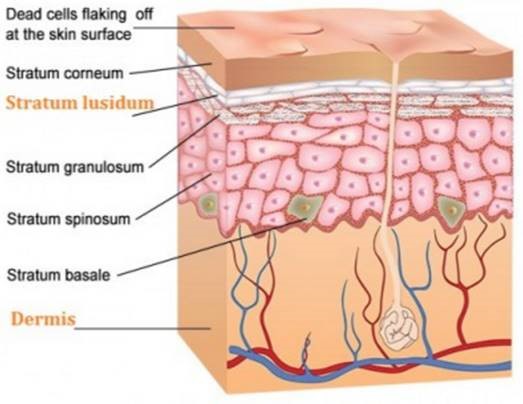Do you understand the structure of the skin? As we age, our skin goes through many changes (most of them unwelcome!) so it’s important to try and keep it as healthy as possible. Knowing a little about the skin’s structure can help us understand how the body’s largest organ functions and how our product and lifestyle choices can affect how we look and feel.
Skin is comprised of three layers: the epidermis at the top, the dermis in the middle, followed by the hypodermis at the bottom. For skincare purposes, it’s the top two layers that we are most concerned about, the epidermis and the dermis.
THE EPIDERMIS
The epidermis contains no blood vessels and is entirely dependent on the dermis beneath it for delivery of nutrients and waste disposal. The epidermis is composed of several layers including the stratum basale, stratum spinosum, stratum granulosum, stratum lusidum (soles of hands and feet only) and stratum corneum. It’s main function is to protect skin by keeping bacteria out while preventing dehydration of the lower layers.
90% of cells in the epidermis are called keratinocytes. These skin cells are found in the stratum basale and as they divide and differentiate, they move from this deeper layer to the more superficial layers. Once they reach the stratum corneum (the largest component of the epidermis), they are shed in the process of skin cell turnover, whereby old skin cells are lost and replaced with healthier new skin cells. This 28-day cycle slows as we age, leaving behind a thicker stratum corneum, which can lead to skin looking dull and lacklustre.
What to do? Exfoliating is key to keeping our skin looking fresh and bright. Professional procedures include microdermabrasion and chemical peels. At home, using products with glycolic acid in a night cream or dedicated treatment will also help shed those extra skin cells. Our favorites are Neostrata 10% Glycolic Renewal Cream and weekly treatment Neostrata Skin Renewal Peel Solution.
Other cells are also found in the epidermis:
- Melanocytes, cells which produce the skin’s pigment, melanin, are found in the basal layer of the epidermis. When exposed to UV rays, melanocytes go into action to produce pigment in the form of a tan or freckles to protect us from the sun. Those of us who are familiar with the ongoing challenge of hyperpigmentation use skin lightening ingredients like hydroquinone, gigawhite and rumex to disrupt the production of melanin and reduce the appearance of dark spots. Although targeting melanin production is an important step in skin lightening, it goes hand-in-hand with sunscreen, retinoids and exfoliants for long-term success.
- Langerhans cells, which help to protect against foreign bodies, are also found in the epidermis.
- Merkel cells, which are specialized in the perception of light touch, are also found here as well as in nail beds and other areas of the skin
THE DERMIS
The primary function of the dermis is to sustain and support the epidermis. This middle layer of the skin contains sweat glands, hair follicles, connective tissues and, most importantly, fibroblasts. These cells are responsible for producing collagen and elastin, both of which are essential in youthful-looking skin. Collagen gives our skin a plump, bouncy fullness while elastin provides the tightness that counteracts sagging and wrinkles. With age, the dermis thins while production of collagen and elastin decreases.
There are steps that we can take to keep the dermis thick and increase collagen and elastin levels. Cold laser therapy and microneedling are two procedures that you may want to consider. If a topical treatment is more your style, it’s tough to beat an effective retinoid. With reams of research to back up its effectiveness and the backing of virtually every dermatologist, you can’t go wrong with this superstar version of vitamin A. Our favorite is gentle but potent Apothekari A is for Anti-Aging retinal serum, a miracle for the skin if ever one existed.
Proving that a healthy epidermis and dermis is more than just skin deep, researchers at McMaster University in Ontario found that after age 40, men and women who exercised regularly had thinner, healthier stratum corneums and thicker dermis layers. In fact, their skin composition was closer to those in their 20’s and 30’s than 40+. For fitness enthusiasts, that’s great news. Just don’t forget the sunscreen when you’re out for that run.




This reminds me of biology classes. The skin consist of three layers endermis, dermis and hypodermis. It is indeed a great news to know that working out could my skin look younger as I only started working out just to gain body weight. Lastly, is there any effect to not creaming the skin.
For Augustus,
Thanks for your comments and question. Applying cream or lotion to the skin is certainly important to replenish lost moisture, especially in the winter when air tends to be dry and cold. Keeping skin properly hydrated is also essential to maintaining healthy barrier function which protects from external assaults like bacteria and pollution. Read more about what to look for in an moisturizer here in our blog.
Best, Sharmani